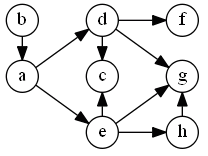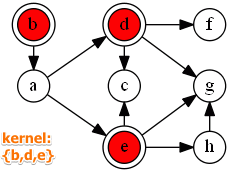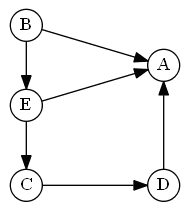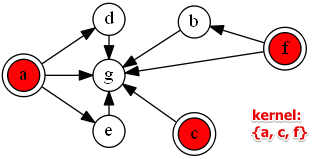Contents
ELECTRE
This is a method from the family of outranking (i.e. based on pair-wise comparison) MCDA methods. The result is a partial ordering of alternatives (see Partial Order Preference Structure)
Here:
- ELECTRE I
ELECTRE I chooses alternatives that are preferred by the majority of the criteria and which don;t cause an unacceptable level of discontentment on other criteria.
Preferences
- Main idea
- When we say $a \ P \ b$?
- (1) if we have a lot of criteria for which $u_i(a) > u_i(b)$ (where $u_i$ - some utility function)
- (2) and we have no strong arguments that say the opposite of (1)
The ELECTRE methods are based on two concepts:
- Concordance Index
- Discordance Index
Concordance Index
Or quantification of positive arguments
For ELECTRE 1, when comparing $a$ and $b$
- identify all criteria $g_j$ such that $g_j(a) \geqslant g_j(b)$
- for all such criteria $g_j$ sum their weights $w_j$,
- let $W$ be the sum of all weights: $W = \sum_i w_i$ (we use this for normalization)
- define the concordance index as:
- $c(a, b) = \cfrac{1}{W} \sum_{j: g_j(a) \geqslant g_j(b)} w_j$
Note that weight should sum up to 1
There are two extreme cases:
- $c(a, b) = 1$: all criteria for $a$ are better than for $b$ (Unanimity)
- have very good reasons to say $a \ P \ b$
- $c(a, b) = 0$: there is no criteria in which $a$ better than $b$
Discordance Index
Or quantification of negative arguments
We want to find a strong argument against $a \ P \ b$
- if we find such an argument then we cannot say that $a \ P \ b$
For ELECTRE I, define $d(a, b)$ as
- 0 when $\forall j: g_j(a) \geqslant g_j(v)$ (none when there's Unanimity)
- if $\exists g_i: g_i(b) \geqslant g_i(a)$ then we have an argument against $a \ P \ b$
- in this case we want to identify the largest difference between $a$ and $b$:
- $\cfrac{1}{\delta} \max_j [g_j(b) - g_j(a)]$
- $\delta$ is normalization factor: $\delta = \max_{i,c,d} [g_i(c) - g_i(d)]$
Another way
- let $D$ be the set of cases where we list cases that cannot be compared
- if for a pair of alternatives $(a, b)$ there exists a criteria $g_i$ s.t. $(g_i(a), g_i(b)) \in D$ then we cannot compare these alternatives
Outranking Preference Relation
For ELECTRE I we define $S \equiv P \lor I$ as: (the "as good as relations", also see Voting Theory Relations)
- $a \ S \ b \iff$
- (1) $c(a, b) \geqslant \tilde c$
- a lot of positive arguments to say $a \ S \ b$
- (2) $d(a, b) \leqslant \tilde d$
- not many negative arguments to say the opposite
- (1) $c(a, b) \geqslant \tilde c$
- so for that we also have to provide two parameters:
- $\tilde c$ - the concordance threshold and $\tilde d$ - the discordance threshold
Or:
- $a \ S \ b \iff$
- (1) $c(a, b) \geqslant \tilde c$
- (2) $\forall g_i: \big(g_i(a), g_i(b)\big) \not \in D$
Note that this relation gives us partial order:
- we have $P$ and $I$ (expressed via $S$)
- and we have $J$ (when discordance threshold is exceeded)
Graph Kernels
Graph Kernels are used to identify good alternatives.
It is possible to express the outranking relation $S$ in form of a directed graph
Example:
-

- $a$ is better than $e$ and $d$
- $d$ is better than $f$ and $c$
- etc
A kernel of a graph $K \subset A$ is
- $\forall a \in K, \not \exists b: a \ S \ b$
- no alternative $a$ inside the kernel $K$ is better than any other alternative $b$ inside $K$
- $\forall a,b \in K: a \ ? \ b$
- within the kernel we cannot say anything about the relation between $a$ and $b$
- $\forall c \not \in K, \exists a \in K: a \ S \ c$
- each alternative $c$ outside of the kernel $K$ is worse than at least one alternative $a$ inside $K$
For the example above:
- $K = \{b, d, e\}$
-

Another example
Remarks:
- If the graph has no cycles then the kernel is unique
- Each cycle can be replaced by a single node (see Strongly Connected Components)
The kernel $K$ of a set $A$ forms a set of preferred alternatives.
Examples
Example 1
| price | comfort | speed | aesthetic | ||
|---|---|---|---|---|---|
| 1 | 300 | ex | fast | good | |
| 2 | 250 | ex | med | good | |
| 3 | 250 | med | fast | good | |
| 4 | 200 | med | fast | med | |
| 5 | 200 | med | med | good | |
| 7 | 100 | poor | med | med | |
| $w$ | 5 | 4 | 3 | 3 | $W = \sum w = 15$ |
Concordance
Perform pair-wise comparisons for all elements $A$
- let's compare (1) and (2)
- concordance: $c(1, 2) = \cfrac{1}{15} (4 + 3 + 3) = \cfrac{2}{3}$
This way we compare each with each:
| 1 | 2 | 3 | 4 | 5 | 6 | 7 | |
|---|---|---|---|---|---|---|---|
| 1 | - | 10 | 10 | 10 | 10 | 10 | 10 |
| 2 | 12 | - | 12 | 7 | 10 | 7 | 10 |
| 3 | 11 | 11 | - | 10 | 10 | 10 | 10 |
| 4 | 8 | 8 | 12 | - | 12 | 12 | 10 |
| 5 | 8 | 11 | 12 | 12 | - | 12 | 10 |
| 6 | 11 | 11 | 11 | 11 | 11 | - | 10 |
| 7 | 5 | 8 | 5 | 8 | 8 | 9 | - |
(note that this is not normalized - need also to divide on 15)
Discordance
In this case we define discordance by enumerating cases that are forbidden
The following tables shows what veto we define
| price | comfort | |
|---|---|---|
| $a$ | 250 | poor |
| $b$ | 100 | excellent |
Graph
So the establish the following relation $S$ and the following graph:

There are two kernels in this case:
- 2, 4, 7
-
- 2, 5, 7
-
Kernel:
- 6 is dominated - remove it
- same for 3 and 1
- since there's a cycle we have to decide between 4 and 5, and remove one of them
- when we put alternatives into a kernel, it doesn't mean they are the best, but it means it allows to apply the Dominance principle and remove dominated alternatives
Example 2
- A company wants to rank 5 candidates $A,B,C,D,E$ for a promotion
- Criteria:
- Reputation of diploma $D$
- Skills $K$
- Personality $P$
- Spoken Languages $L$
- Seniority $S$
- Apply ELECTRE with concordance threshold 0.6 and discordance 6
The following evaluation table is obtained
| $A$ | $B$ | $C$ | $D$ | $E$ | Weight | |
|---|---|---|---|---|---|---|
| $D$ | 7 | 11 | 15 | 11 | 16 | 15 |
| $K$ | 12 | 18 | 6 | 8 | 10 | 15 |
| $P$ | 13 | 13 | 14 | 19 | 10 | 15 |
| $L$ | 18 | 16 | 19 | 13 | 19 | 25 |
| $S$ | 10 | 20 | 16 | 14 | 20 | 20 |
Total weight is $W = 15 + 15 + 15 + 25 + 20 = 100$
Concordance
Then we construct the concordance index by comparing alternatives pair-wise
For example, consider alternatives $A$ and $B$
| $A$ vs $B$ | $B$ vs $A$ | |
|---|---|---|
| $D$ | 15 | |
| $K$ | 15 | |
| $P$ | 25 | 25 |
| $L$ | 25 | |
| $S$ | 20 | |
| Total | 50 | 100 |
| Normalized | 0.5 | 0.75 |
Repeating this for all pairs, construct the following table:
| $A$ | $B$ | $C$ | $D$ | $E$ | |
|---|---|---|---|---|---|
| $A$ | - | 0.75 | 0.15 | 0.4 | 0.4 |
| $B$ | 0.5 | - | 0.35 | 0.75 | 0.6 |
| $C$ | 0.85 | 0.65 | - | 0.6 | 0.5 |
| $D$ | 0.6 | 0.25 | 0.4 | - | 0.25 |
| $E$ | 0.6 | 0.6 | 0.75 | 0.75 | - |
Bold are alternatives that should be preferred provided that there's no discordance
- recall that $\tilde c = 0.6$ and we check all values that $\geqslant \tilde c$
Discordance
The discordance index is $\tilde d = 6$
- we don't normalize on $\delta$ here because our values are already normalized
Let's compare $A$ with $B$ and $A$ with $C$:
| $A$ vs $B$ | $B$ vs $A$ | $A$ vs $C$ | $C$ vs $A$ | |
|---|---|---|---|---|
| $D$ | 7 | - | 8 | - |
| $K$ | 6 | - | - | 6 |
| $P$ | 0 | 0 | 1 | - |
| $L$ | - | 2 | 1 | - |
| $S$ | 10 | - | 6 | - |
| Max | 10 | 2 | 8 | 6 |
| Rel | $A \ J \ B$ | $A \ J \ C$ | $C \ J \ A$ |
- if a difference exceeds the threshold, the alternatives are incomparable
Graph
Based on the Concordance and Discordance we define the outranking relation $S$
- this relation can be depicted as a graph
-

Sources
- Decision Engineering (ULB)
- http://web.itu.edu.tr/~topcuil/ya/MDM08Outranking.pptx
- http://electre.no.sapo.pt/MElecI2.htm
- Multiple Criteria Decision Analysis: State of the Art Surveys, 2005


